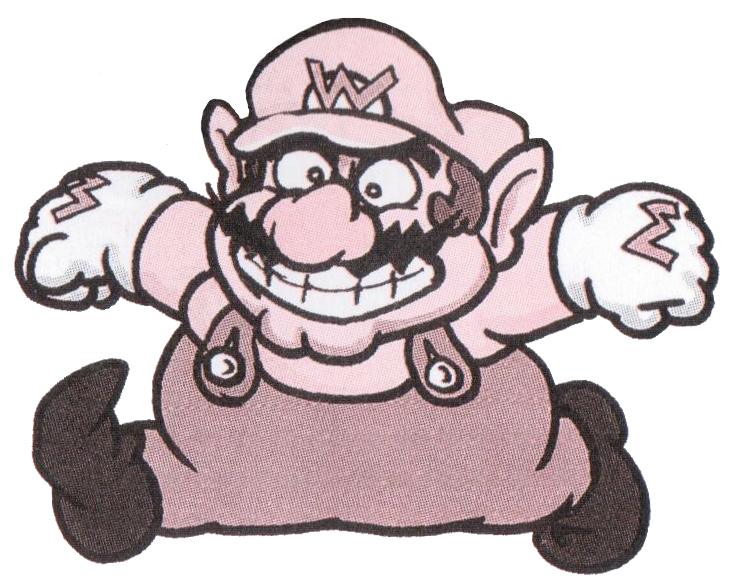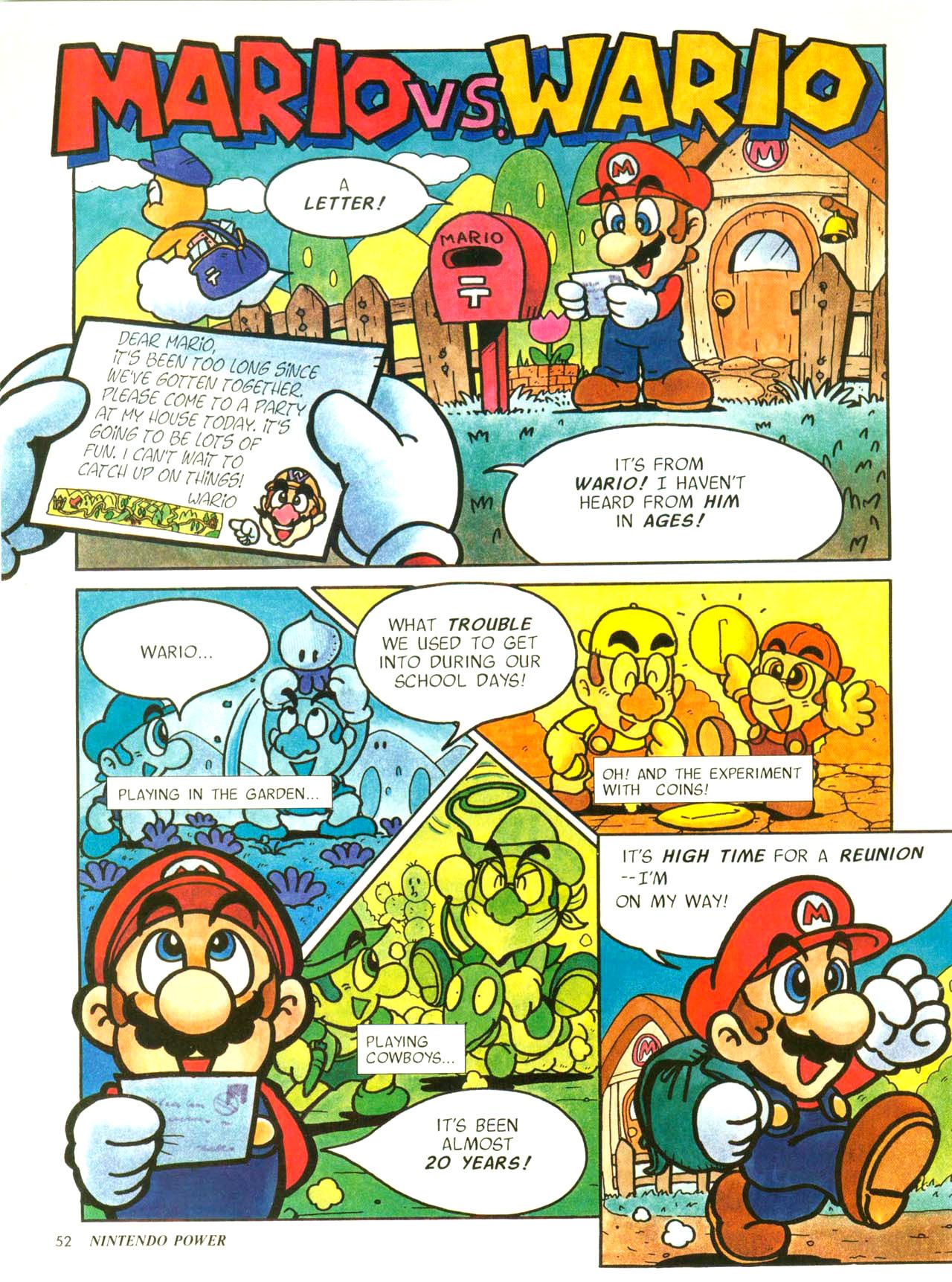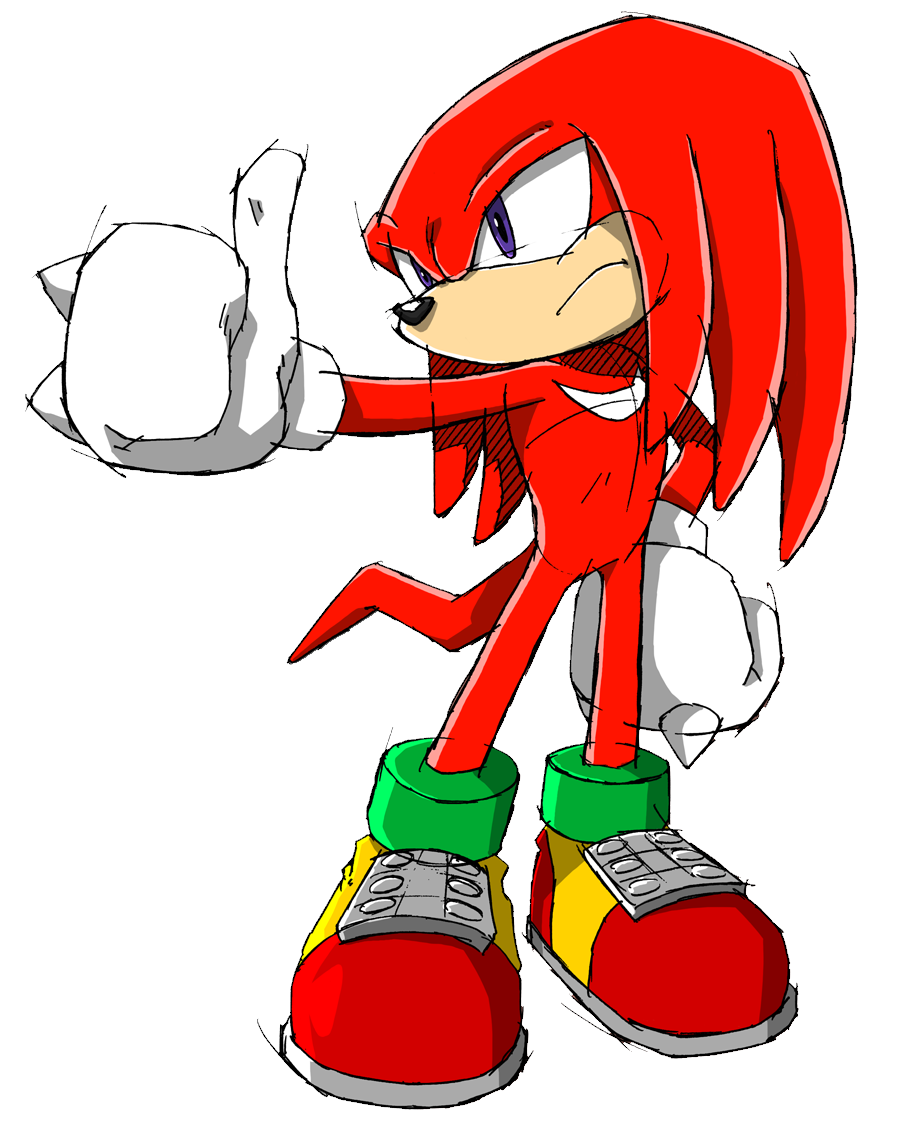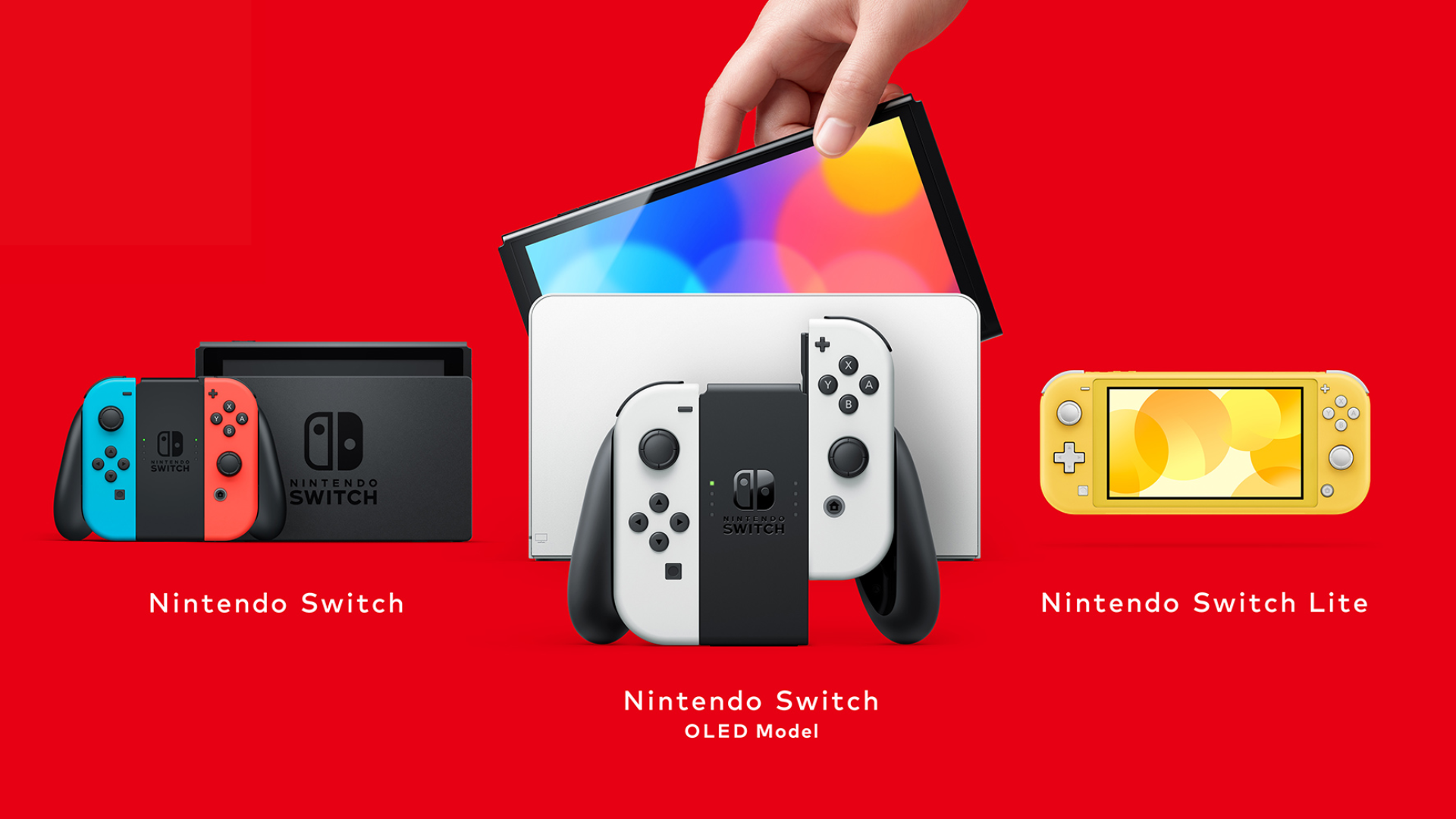Welcome to another installment of Character Spotlight: the segment where we analyze video game characters. Today we shine the light on Nintendo's resident anti-hero: Wario from the Mario series, and later the Wario Land and WarioWare series!
Wario made his first appearance in the 1992 Game Boy game: Super Mario Land 2: 6 Golden Coins. In this game, Wario takes over Mario's Castle (what!!!!???) and so, our favorite mustached plumber must go on a quest to obtain the titular six Golden Coins in order to reclaim the land. Wario casts a large shadow over the handheld adventure until the final confrontation, where he is revealed to be a gigantic brute roughly 4 times the size of Mario.
Wario was created by Hiroji Kiyotake, designer of Samus. Some fan speculation suggests that he might be a reversion or a perversion of the character Foreman Spike from the Famicom/NES B-title Wrecking Crew. In a (now archive-only) 2000's interviews with n-sider and (the now defunct) Kombo.com, the team at Nintendo R&D1 -- the folks who brought us Kid Icarus and Metroid -- had a certain degree of contempt over make game series starring a character they did not create; that is to say the Super Mario Land games. As loved as the Super Mario Land games were, for R&D1, it was just a job for them. A task. Wario was a response to this disdain. Their rationale was that even if he was a derivative of Mario, he was a character they created.
"…were able to create a new character, one of their very own that would symbolize [our] situation."
So, who is Wario exactly? Where did he come from? When I was younger, I had heard that he Mario's evil brother, or his evil cousin. I've heard some rumblings that maybe he's an evil shadow clone or the personification of Mario's id. Some unofficial sources even call him (hopefully erroneously) "Mario's alter ego". So, is he Mario's evil twin? Does Mario have some kind of Jekyll-n-Hyde complex? Is Mario a Wolfman?
Based on the information provided in the manual for Super Mario Land 2, Super Smash Bros. Melee, Nintendo Power comics (Super Mario Adventures and Mario vs Wario), and the Super Mario-kun manga, I am forced to make the following, conclusion: he is a separate person. He is merely... a guy. A guy from Mario's childhood who wanted to be Mario's friend and playmate but would ultimately come to resent Jumpman. Mario more or less unintentionally bullied Wario, and Wario held this against Mario for years (as is explained in the possibly apocryphal Nintendo Power comics). All of this raises so many questions. Did Wario grow up in Our World with Mario? Did they grow up in the same community? If Mario is an Italian-American, is Wario also an Italian-American? Or did Wario grow up with Mario in the Mushroom Kingdom? Why does one of Mario's childhood peers have essentially his exact same name, but one letter is turned upside down? Is Wario some obsessed stalker who modeled his entire appearance over essentially parodying Mario? How old are these people supposed to be anyway? We'll probably never know.
Wario's design traits are a clear response to Mario. Mario is overweight. He's just a little bit chubby. Wario, on the other hand, IS OBESE. Mario has a bulbous nose. Wario has a triangular nose that looks like a big pimple. Mario's mustache is all curvy and rounded. Wario's zigs and zags. Mario's shoes look immaculate. Wario's got the Wizard of Oz curly shoes. Mario's enemies (with some exceptions, I won't lie!) are mostly cute and cuddly, so much so that you might even feel a little bit bad every time you stomp on a Goomba or a Koopa or throw a vegetable at a Shy Guy; Wario's rogues' gallery consists of some ugly sons-a-guns, some of which are distortions of Mario’s classic malcontents.
But beyond his troll-like, somewhat elven look, Wario's defining character traits -- his greed, his narcissism and his envy-- are extremely negative. He's a dark mirror image of Mario. They're like the Goofus and Gallant of the Nintendo World. Mario is selfless. Wario is selfish. Mario is a goofy, but noble hero through-and-through. Wario either helps out people accidentally or only gets involved if there's some treasure or prize to be obtained. "What's in it for Wario?" And yet, Nintendo consistently plays the ugliness of Wario's personal traits for laughs. In the WarioWare series, Wario makes games based on himself and in one instance (“Super Wario Bros.”) is a blatant rip-off of Mario's hallmark title. He was never able to stop envying Mario.
The music in the Mario games is upbeat, bouncy and happy. The music in Wario's games is deep, low-pitched, ugly and dissonant sounding.
Wario would make another major appearance in the Japanese-exclusive Super Famicom title Mario & Wario by Game Freak. In the puzzle point-and-click puzzle game, Wario creates trouble for Mario and friends by putting buckets on their hands. Even though Mario and Wario's names were in the title, this was really the fairy Wanda's game.
In early 1994, Wario finally got the headline his own title: Super Mario Land 3: Wario Land. In Wario Land, the big brute decided to get his own castle. He journeyed to Kitchen Island to steal a treasure from the Brown Sugar Gang, lead by Captain Syrup the lady pirate. The game played much like the Mario Lands before it, but with a pirate theme and more punching. The game is much more refined than Mario Lands 1 and 2 and I'd say it's the best of the 3, it's one of my top ten original Game Boy games. Always a favorite.
Wario would end his first solo adventure triumphant: his life-long wish fulfilled… he gets his own castle!
Later that year, Wario would antagonize Toad in Wario’s Woods, the final official NES game and butted heads with Bomberman in Wario Blast also for Game Boy (A modified version of Bomberman GB for NA and PAL territories). No longer did the game-purchasing public need to be reminded where he came from: Wario now had enough marquee value to be able to sell his own games.
Virtual Boy Wario Land followed not too much later in the Winter of 1995. The lesser remembered sequel to the original game, VB Wario Land, sadly flopped (as did the Virtual Boy console and its entire software library) and was not terribly liked in its day. It has since by vindicated by the passage of time. In retrospect, it's seen as the crowning achievement of the Virtual Boy library. There are quite a few people I know who will swear up and down that it's criminally overlooked, underrepresented and the best Wario game, no contest. There a loud minority, but the game does have its' fans.
Wario would later go head to head with Mario in Picross 2 for Game Boy (a Japan exclusive) and, more prominently appear in Mario Kart 64 as a playable racer. With only 8 slots, something had to give. My headcanon is that Donkey Kong Jr. grew into Donkey Kong, and Wario beat up Koopa Troopa, tied him up in a closet somewhere and stole his kart. And I base that on absolutely nothing.
The Wario Land sequel that was better known to the public — Wario Land II came out for Game Boy in North America in the spring of 1998, with the color version -- Wario Land II DX (Known in Japan as Wario Land 2: The Stolen Treasure) -- body-slammed it's way into stores later that year in Japan. The North America and European versions would follow very shortly afterward in February of 1999. Wario Land II, specifically the DX version was very well liked, sold very well and was considered to be a must-own title for the Game Boy Color, a borderline killer-app. The other competition was mostly internal: the Pokémon Generation 1 family. This game continued Wario battles with the Brown Sugar Pirates and Captain Syrup as he fought to reclaim his newly obtained castle.
What made Wario Land II such a hit with casuals and obsessive gamers was its focus on exploration. Less of straight-up platformer, Wario Land II was more of an action-adventure game. The narrative of the game twisted and turned depending on what path you take in specific stages, certain puzzles you solve. With several ultimate outcomes for Wario, the game had a whole lot of replayability.
Wario Land II was helmed by Takehiko Hosokawa rather than Hiroji Kiyotake and with a new director, came a new direction that would with this game and carry on into the next one. Wario was essentially immortal in Wario Land II (3 as well, with one exception that I'll get to in part 2 of this series). There were no extra chances, lives or 1ups. There were no games overs. There were no hit points. If you took a hit, you lost coins, sometimes you bounce out of a boss arena, but speaking in extremely general terms, taking damage was consequence-free. Generally. The game was less about a challenge and more about navigating a game world.
Wario himself gave a bunch of asides and self-congratulatory commentary in the manual for Wario Land 2; a trend that would continue in later games…
To aid in this new direction, Wario Land II would introduce a game mechanic that would not only be a staple function for Wario Lands 3 and 4 as well, but also serve as a character trait: Adaptability. Some enemies or situations transformed Wario. (The Wario Land 2, 3 and 4 manuals refer to these transformations as “Reactions”) For example, if Wario was set on fire, he would run with his ass blaze around until became a big flaming ball that eventually burned out. You could use the Fire Wario form to break certain blocks; clear certain pathways. Other situations that being set on fire could be a nuisance rather than something that in other games would be a disadvantage. The game makers not only found a way to ingratiate this idea into the level design of several Wario games, but elaborated on Wario’s character: he physically adapts to tough situations.
Other ways transformations that can be used to find new paths: Tiny Wario (formerly Wario being one hit away from death….), now allowed you to get into tighter spaces; there's a zombie that barfs on Wario, turns him into The Walking Dead, a form that is used to jump through floors, Drunk Wario belches toxic balls of fire at his foes... The seeds of the disgusting humor that would become a Wario trademark would be planted here.
Well, we just covered a good 6 eventful years of game history. Stay tuned to GameTyrant for Part 2 of this series, as we discuss Wario Land 3 and Wario Land 4. In the meantime, I'll be sitting here pondering how the hell Mario got his own damn castle in between articles. Ciao!






























